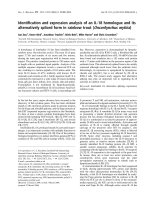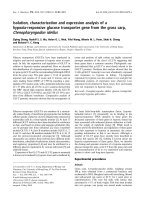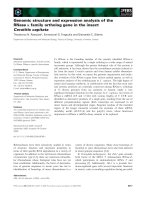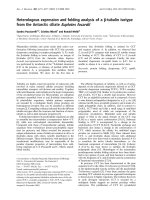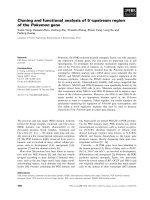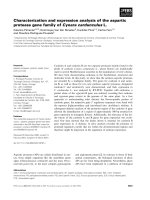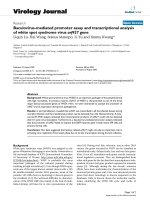Molecular cloning and expression analysis of a heat shock protein (Hsp90) gene from black tiger shrimp (Penaeus monodon)
Bạn đang xem bản rút gọn của tài liệu. Xem và tải ngay bản đầy đủ của tài liệu tại đây (669.76 KB, 8 trang )
Mol Biol Rep (2009) 36:127–134
DOI 10.1007/s11033-007-9160-9
Molecular cloning and expression analysis of a heat shock protein
(Hsp90) gene from black tiger shrimp (Penaeus monodon)
Shigui Jiang Æ Lihua Qiu Æ Falin Zhou Æ
Jianhua Huang Æ Yihui Guo Æ Keng Yang
Received: 19 August 2007 / Accepted: 28 September 2007 / Published online: 13 October 2007
Ó Springer Science+Business Media B.V. 2007
Abstract The techniques of homology cloning and
anchored PCR were used to clone the Hsp90 gene from
black tiger shrimp. The full length cDNA of black tiger
shrimp Hsp90 (btsHsp90) contained a 50 untranslated
region (UTR) of 72 bp, an ORF (open reading frame) of
2160 bp encoding a polypeptide of 720 amino acids with an
estimated molecular mass of 83-kDa and a 30 UTR of
288 bp. The sequence of the coding region showed 90 and
84% homology with that of the Chiromantes haematocheir
and Homo sapiens, respectively. Conserved signature
sequences of Hsp90 gene family were found in the
btsHsp90 deduced amino acid sequence. The temporal
expressions of Hsp90 gene were constitutively in the black
tiger shrimp tissues including liver, ovary, muscle, brain
stomach, and heart, and their levels were markedly
enhanced after 30-min heat treatment at 37°C. In ovarian
maturation stages, the expression of btsHsp90 was strongest in the second stage, weaker in the fourth and first stage.
Keywords Cloning Á Hsp90 Á RT expression Á
Black tiger shrimp (Penaeus monodon)
Introduction
Animals are capable of producing proteins in response to
environmental changes such as temperature elevation [1],
exposure to oxidative stress [2], and myocardial ischemia
[3, 4]. These proteins are highly conserved among various
S. Jiang (&) Á L. Qiu Á F. Zhou Á J. Huang Á Y. Guo Á K. Yang
Biotechnology and Aquiculture Laboratory, The South China
Sea Fisheries Research Institute, Chinese Academy of Fishery
Sciences, 231 Xingangxi Road, Guangzhou 510300, P.R. China
e-mail:
organisms and collectively termed heat shock proteins
(Hsps). According to their apparent molecular weights and
degrees of homology, Hsps are classified into several
families, Hsp90s (83–99 kDa), Hsp70s (68–80 kDa),
Hsp60s, and the small Hsps (25–28 kDa) [1].
Heat shock protein 90 (Hsp 90) is one of the most
abundant cytosolic proteins in eukaryotes, amounting to
approximately 1% of soluble protein in some cells even in
the absence of stress [5]. Reported roles for Hsp90 family
members include protein chaperoning protect cells against
stress [6], oncogenic transformation [7, 8], cell cycle control [9] and antigen presentation [10]. It possesses the
ability to refold denatured proteins into proper conformations [11], associates with steroid hormone receptors and
maintains them in a non-functional state until hormone
binding [12, 13]. Hsp90 also interacts with other nuclear or
cytoplasmic proteins, including transforming or regulatory
tyrosine kinases, some serine/threonine kinases, transcription factors, cytoskeletal proteins, calmodulin, and bc
subunits of G proteins [9, 14–18]. The deletion of Hsp90 is
lethal for eukaryotic cells [5, 19, 20]. Under non-stress
conditions, Hsp90 has been shown to play a key role in
many cellular processes and most of its identified cellular
targets are signal transducers whose conformational instability is relevant to their roles as molecular switches. Under
stress conditions, Hsp90 prevents irreversible aggregations
of proteins. Hsp90 is a participant in the heat shock (stress)
response of the cell, a response which is widely recognized
and accepted as a major weapon in the cell’s armamentarium for protection against and recovery from environmental
insult, both physical and chemical [6, 21–23].
With the development of the technique of gene cloning,
molecular techniques have recently enabled the identification of Hsp90 genes from the invertebrates, such as:
Metapenaeus ensis (GenBank accession No. EF470346),
123
128
Mol Biol Rep (2009) 36:127–134
Litopenaeus setiferus (GenBank accession No. BE846722),
Chiromantes haematocheir (GenBank accession No.
AY528900), Bemisia tabaci (GenBank accession No.
DQ093381), Ceratitis capitata (GenBank accession No.
CAJ28987), Locusta migratoria (GenBank accession No.
AY445913). In the Fenneropenaeus chinensis, partial
sequence of Hsp90 was cloned using SSH and found the
gene was up-regulated in the hepatopancreas during WSSV
infection [24]. In this report, we describe the cloning,
sequencing, and expressions of the 83-kDa Hsp90 gene
from the black tiger shrimp (Penaeus monodon). The main
objectives of this study are (1) to clone the full length
cDNA of Hsp90 from black tiger shrimp and compare it to
other known Hsp90 genes to prove the existence of Hsp90
in black tiger shrimp, (2) to investigate the expression
pattern of Hsp90 gene in the tissues in defending environmental temperature change, (3) to detect if the
expression has difference during the three important
ovarian maturation stages primarily because the Hsp90
gene could strongly expressed in the ovary without
stimulation.
Table 1 Oligonucleotide primers used in the experiments
Primer name
(50 ? 30 ) Nucleotide sequence
Fe
TGATTGGACAGTTYGGTGT
Re
TACAGYTTGATTTGTTCTT
F1
GCCGACAAGGTGACCGTAGT
R1
TGTTCTTCTGCTTGCGGTTC
R2
TCCTCCCAGTCGTTGGTCAG
Oligo-dT adaptor
GGCCACGCGACTAGTAC(T)16
Adaptor
GGCCACGCGACTAGTAC
Oligo-dG
GGGGGGGGGGGGGGGH
b-Actin F
TTGCTACATCGCCCTTGACT
b-Actin R
TGTGGACGGTTTCCTGAATA
F
R
CCACGAGGATTCCACCAACC
CCTTCGTCACCGAGACAAGC
reagent following the protocol of the manufacturer, and
resuspended in DEPC-treated water and stored at –80°C.
Synthesis of the cDNA first strand
Materials and methods
Shrimp
About 40 appear healthy black tiger shrimps (P. monodon)
with fresh weight of about 60–300 g each were purchased
from Sanya, Hainan province, P. R. China. The shrimp
were cultivated in the aerated seawater (salinity 30) for
3 days at 24–25°C. Then they were used as the examined
materials in the following examination.
(1)
(2)
Gene cloning: The shrimps were cultivated without
heat stimulation prior to the RNA was isolated from
the ovary.
Expression: Three shrimp (fresh weight about 200 g)
were cultivated for 30 min at 37°C prior to the RNA
was isolated from the tissues including hepatopancreas, ovary (belong to the yolky stage, [25]), muscle,
brain stomach, heart. Three appear healthy shrimp
cultivated at 24–25°C were used as the control.
In each ovarian maturation stages, three shrimp without
heat stimulation were selected which were classified
according to the report of Huang [25] before the RNA was
isolated from ovary. O1: primordial germ cell stage; O2:
chromatin nucleolus stage; O4: yolky stage.
Total RNA isolation
Total RNA was isolated from the examined tissues (weight
50 mg) of the shrimps using Trizol (Invitrogen, Japan)
123
cDNA was synthesized from 2 lg of total RNA by
Moloney Murine Leukemia Virus reverse transcriptase
(M-MLV, Promega, USA) at 42°C for 50 min with oligodT-adaptor primer (Table 1) following the protocol of the
manufacturer. The cDNA was used as the template for PCR
reactions in gene cloning and expression analysis.
Gene cloning and sequencing
Initially, PCR was performed using the cDNA prepared
above as template, with the degenerated primers of Fe and
Re (Table 1) designed according to the conserved regions
of other known Hsp90 gene sequences (such as Xenopus
Laevis, Danio rerio, Homo sapiens, Chlamy farreri), in
order to obtain the partial fragment of Hsp90 gene from the
shrimp. The obtained PCR products were separated by
1.2% agarose gel, and then purified by PCR purification kit.
The purified PCR product was ligated with the PMD20-T
vector (Takara, Japan), and transformed into the competent
Escherichia coli cells. The recombinants were identified
through blue–white color selection and screened with M13
forward and reverse primers. Three of the positive clones
were sequenced on an ABI3730 Automated Sequencer
(Applied Biosystem). Sequences generated were analyzed
for similarity with other known sequences using the
BLAST programs ( />Having isolated a partial Hsp90 sequence, the 50 and
0
3 ends of mRNA were obtained by rapid amplification of
cDNA ends (RACE) methods, using gene-specific primers
Mol Biol Rep (2009) 36:127–134
129
Fig. 1 The Black tiger shrimp Hsp90 gene sequence. Hsp90 family c
signature motif sequence was highlighted; the spark showed the stop
code. The polyadenylation signal sequence (AATAAA or AATAAT)
is underlined, the RNA instability motif were highlighted and
underlined, GxxGxG motif is in box. Potential phosphorylation sites
are underlined
shown in Table 1. In 30 RACE–PCR, PCR reaction was
performed with primer F1 and adaptor primer (Table 1). In
50 RACE–PCR, the first strand cDNA obtained was tailed
with poly (C) at the 50 ends using terminal deoxynucleotidyl transferase (TdT, Takara, Japan). PCR was performed
initially with primer R1 and Oligo-dG, followed by seminested PCR with R2 and Oligo-dG. The PCR products
were gel-purified, sequenced, and the resulted sequences
were subjected to analyze.
Generated sequences were analyzed for similarity with
other known sequences using the BLAST program (http://
www.ncbi.nlm.nih.gov/BLAST/). Multiple sequence alignments were performed using the CLUSTAL W program at
the European Bioinformatics Institute (http://www.
ebi.ac.uk). Analyses of the deduced amino acid sequences
utilized the programs PSORT (Kenta Nakai, National Insitute Basic Biology), Scan Prosite (EXPASy Molecular
Biology Server) and Predict Protein (EMBL-Heidelberg).
The phylogenetic tree was constructed by the neighborjoining (NJ) method using using the programs of CLUSTAL
X1.83 [26] and MEGA3.1 [27].
Expression studies
Reverse transcription PCR was used to study the temporal
expressions of Hsp90 in black tiger shrimp.
Gene specific primers F and R, which gave rise to a
product of 293 bp, were used in RT-PCR to detect the
temporal expression of the Hsp90 gene in black tiger
shrimp. The products were cloned, sequenced and confirmed to be the correct form of Hsp90 gene. Primer b-actin
F and b-actin R were used in the RT-PCR to amplify a
220 bp fragment of black tiger shrimp b-actin gene (GenBank accession No. EF087977) as a positive control to
verify the successful transcription and to calibrate the
cDNA template for correspond samples. The products were
cloned, sequenced, and confirmed to be the correct form of
b-actin gene.
Results
Cloning and sequence of btsHsp90 gene
Three overlapping products were obtained by RT-PCR
amplification (Fig. 1), which comprised the full-length
123
130
Mol Biol Rep (2009) 36:127–134
btsHsp90 cDNA. The sequence consisted of 2523 nucleotides including a 2160 bp single open reading frame
(ORF), a 72 bp 50 untranslated region (50 UTR) and a
288 bp 30 UTR. In the 30 UTR, there were two RNA
instability motifs (ATTTA), a 24 bp poly (A) tail and two
polyadenylation signal which located 40 and 20 bp,
respectively, upstream of the poly (A)+ tail. The ORF
encoded a 720 amino acids precursor peptide with a
molecular weight about 83 kDa, and theoretical point of
4.9. The complete nucleotide sequence of btsHsp90 cDNA
and the deduced amino acid sequence are shown in Fig. 1.
The software search yielded several obvious sequence
motifs or domains. In the deduced amino acids, there are
five Hsp90 family signature motifs and a GxxGxG motif
essential for ATP binding showed in the Fig. 1; a Histidine
kinase-like ATPases (HATPase-c) domain from aa33 to
aa187; N-glycosylation sites: NSSDaa44–aa47, NKTKaa279–
aa282
, NISRaa385–aa388, NTSKaa428–aa431; two coiled coil:
212
Lys –Val248, Leu537–Asp565 (they were not shown in the
Fig. 1).
Homology analysis
The deduced amino acid sequence of the btsHsp90 shows
very high homology with that of the other invertebrates:
C. haematocheir (90% Identity, E = 0), L. migratoria
(85% Identity, E = 0), B. tabaci (80% Identity, E = 0);
even with the mammalians: Mus musculus (84% Identity,
E = 2e – 102), H. sapiens (84% Identity, E = 6e – 60)
(Table 2). Multiple sequence alignments show the high
conserved with the other species Hsp90. It shows that the
different potential btsHsp90 motifs are in conserved positions (Fig. 2) and it indicated that btsHsp90 should have
the similar functions with the other animals Hsp90 gene.
Based on the nucleotide acid sequence of Hsp90 genes, a
phylogenetic tree was constructed by using the programs of
CLUSTAL X1.83 and MEGA3.1 (Fig. 3). All the vertebrate’ Hsp90 genes and invertebrate’ Hsp90 genes were
Table 2 Homology of Hsp90
protein of black tiger shrimp
with other known Hsp90 amino
acid
Expression studies
A product of 293 bp of expected size was amplified from
most of the examined tissues including hepatopancreas,
ovary, muscle, brain, stomach, and heart. The sequences of
the resulting RT-PCR products were identical to the Hsp90
cDNA sequences which indicated the mRNA expression
could be detected by RT-PCR. The expression of the
btsHsp90 was observed in the most of the examined tissues, but the expression level varied significantly among
the tissues. There was a high level in ovary and hepatopancreas, lower in brain, stomach and heart, while lowest
in muscle. After stimulated with heat treatment, the Hsp90
expression level was enhanced, especially in the brain,
stomach and heart (Fig. 4).
The Hsp90 expression in the ovary was found to be
different in the ovarian maturation stages by RT-PCR
analysis. The expression level in the second stage (O2) is
the highest among the three stages, and it is higher in the
fourth stage (O4) than in the first stage (O1) (Fig. 5).
Discussion
The Hsp90 family is a group of abundantly expressed and
highly conserved molecular chaperones whose exact
function is presently undefined. They recognize and regulate the activity of several intracellular substrates and also
operate in the absence of stress [11].
In the present study, we cloned full length of Hsp90
gene from the black tiger shrimp (P. monodon) using the
Score (bits)
Chiromantes haematocheir
Bemisia tabaci
Identity (%)
E-value
Accession number
721
91
0
AY528900
1011
80
0
AAZ17403
Ceratitis capitata
999
81
0
CAJ28987
Locusta migratoria
694
85
0
AY445913
Spodoptera frugiperda
685
84
2e – 100
AF254880
Salmo salar
989
78
0
AAD30275
Xenopus Laevis
123
clustered together and formed a group, respectively. In the
tree, the black tiger shrimp shows the closest relationship
with the C. haematocheir, the result is similar with the
result of the BLAST. So the relationships displayed in the
phylogenic tree were corresponded to their classification
position.
1013
80
0
AAV41061
Gallus gallus
685
84
8e – 102
P11501
Mus musculus
683
84
2e – 102
BC094024
Homo sapiens
682
84
6e – 60
AJ890083
Mol Biol Rep (2009) 36:127–134
131
Fig. 2 Multiple alignments of
black tiger shrimp Hsp90 with
other known Hsp90 amino acids
sequences aligned by the
CLUSTAL W program.
Identical and similar sites were
shown with sparks (*) and dots
(. or : ), respectively; Residues
involved in hydrogen bonding
with geldanamycin are
highlighted. GxxGxG motif is
indicated by overline. Hsp90
signature sequences were in the
box. Organism and GenBank
database accession nos. for
sequence are: Xenopus Laevis
(AAV41061), Bemisia tabaci
(AAZ17403), Ceratitis capitata
(CAJ28987), Salmo salar
(AAD30275), Chiromantes
haematocheir (AY528900),
Locusta migratoria
(AY445913), Gallus gallus
(P11501), Mus musculus
(BC094024), Homo sapiens
(AJ890083), Spodoptera
frugiperda (AF254880),
Penaeus monodon
(unsubmitted)
technique of homology and RACE (GenBank accession
No. ZF015589). In 30 UTR, there are two repeats of the
sequence ATTTA which known to decrease both the stability and translation efficiency of an mRNA [28, 29].
There are two polyadenylation signal sequences, one is
AATAAA, same as most animals, the other is AATAAT
which is same as Oomycete (Achlya ambisexualis) [30].
The reason why there are two polyadenylation signal
sequences we do not know now and there is no any report
about it.
123
132
Fig. 3 Phylogenetic tree
show the relationship among
the full-length black tiger
shrimp Hsp90 amino acids
sequence with other
representative Hsp90
sequences. The sequences
were aligned by
CLUSTAL W program
and the phylogenetic
tree was constructed by
neighbor-joining methods
using MEGA version 3.1
Mol Biol Rep (2009) 36:127–134
82
89
Bemisia tabaci
Locusta migratoria
90
Spodoptera frugiperda
Ceratitis capitata
Chiromantes haematocheir
100
100
Penaeus monodon
Xenopus Laevis
Salmo salar
Gallus gallus
99
Mus musculus
100
100
Homo sapiens
Fig. 4 RT-PCR analysis of
Hsp90 expression in various
tissues of black tiger shrimp.
RTC reverse transcription
negative control. Hep,
hepatopancreas; Ov, ovary;
Mu, muscle; Br, brain; St,
stomach; He, heart
Fig. 5 RT-PCR analysis of Hsp90 expression in ovarian maturation
stages. O1: primordial germ cell stage; O2: chromatin nucleolus
stage; O4: yolky stage. RTC reverse transcription negative control
The result of the homology analysis with other known
Hsp90 genes revealed that btsHsp90 showed high homology with Hsp90s of the C. haematocheir over 90%,
whereas a lower homology was observed with mammals
such as H. sapiens and M. musculus of 84% approximately
[31, 32]. The results of the blast indicated that the E-values
were lower than 0.005 [33], so the clones was the homological gene of Hsp90. Five typical Hsp90 family signature
motifs could also be found in the predicted protein of this
sequence, we could think that the clones should be the
member of Hsp90 family and had similar primary structure
with other known Hsp90.
The sequence of btsHsp90 contained a highly hydrophobic and acidic C-terminal end, but no potential Nterminal signal sequence as expected for a secreted protein.
The glutamine-rich sequence (TQTQDQ) or the sequence
PEETQTQDQPME at the amino terminus of the mammals
123
Hsp90 is phosphorylated by the dsDNA-activated protein
kinase [34]. Lacking both amino-terminal threonines,
btsHsp90 cannot be phosphorylated. Together with Hsp70
and Hsp60, Hsp90 helps newly synthesized proteins to fold
and modulate the transcription factors and protein kinases
[19, 35]. The amino terminal domain of btsHsp90 showed
high homology with other Hsp90s and contained a GxxGxG
motif essential for ATP binding [36]. The motif also overlaps with the GA binding motif [37]. The presence of the
EEVD motif at the C-terminal end suggests the cytosolic
localization of btsHsp90 [38, 39]. And the functional motif
sequences all locate in the conserved domains (Fig. 2). The
structure analysis suggests that the btsHsp90 should have
similar function with the other animals’ Hsp90 gene.
Similar to Hsp70, the Hsp90 is also a molecular
chaperone, which is conserved among all living organisms
to protect cells against stress [11, 40]. In the present
study, tissue-specific differences in levels of constitutive
Hsp90 were observed. The highest expression levels were
in ovary not hepatopancreas, the lowest in muscle.
Intermediate levels were detected in hepatopancreas,
brain, heart, and stomach. Our findings are almost in
agreement with those found in rabbits [41] and porcine
[42, 43] which the highest level is in testis. Mammalian
Hsp90 are expressed at basal levels under unstressful
conditions; various stresses increase the expression to
different degrees [42]. In black tiger shrimp, heat treatment could induce the Hsp90 expression level in the
tissues. But the highest also was in the ovary. Now we do
Mol Biol Rep (2009) 36:127–134
not really understand the reason why the highest expression level was in the ovary not in the immune organ, and
there was any report about it. The result indicated that
btsHsp90 was constitutive and inducible expressed and
could play a critical role in defending the circumstantial
temperature elevation.
The levels of constitutive Hsp90 in ovarian maturation
stages were different. When the ovary began to mature, the
expression level was the highest. But the expression levels
were lower in the other two stages. So the Hsp90 expression level could change during the ovarian maturation
stages. From the result we deduced that the Hsp90 might
have relationship with the ovarian maturation. Certainly
this need further work to verify.
Acknowledgments This study was supported by National nature
foundation of China (No. 30571447), National ‘‘863’’ Project of
China (No. 2003AA603120 ) and Agriculture Department Project of
China(06-05-01B).
References
1. Lindquist S, Craig EA (1988) The heat-shock proteins. Annu Rev
Genet 22:631–677
2. Liao F, Andalibi A, Qiao JH, Allayee H, Fogelman AM, Lusis AJ
(1994) Genetic evidence for a common pathway mediating dative
stress, inflammatory gene induction, and aortic fatty streak formation in mice. J Clin Invest 94:877–884
3. Benjamin IJ, Williams RS (1994) Expression and function of
stress proteins in the ischemic heart. In: Morimoto RI, Tisserees
A, Geogopoulos C (eds) The biology of heat shock proteins and
molecular chaperones. Cold Spring Harbor Laboratory Press,
Cold Spring Harbor, NY, pp 533–552
4. Mestril R, Dillmann WH (1995) Heat shock proteins and protection against myocardial ischemia. J Mol Cell Cardiol 27:45–52
5. Buchner J (1999) hsp90 and Co.—a holding for folding. Trends
Biochem Sci 24:136–141
6. Craig EA, Weissman JS, Horwich AL (1994) Heat shock proteins
and molecular chaperones: mediators of protein conformation and
turnover in the cell. Cell 78:365–372
7. Gress TM, Muller-Pillasch F, Weber C, Lerch MM, Freiss H,
Buchler M, Beger HG, Adler G (1994) Balance of expression of
genes coding for extracellular matrix proteins and extracellular
matrix degrading proteases in chronic pancreatitis. Cancer Res
54:547–551
8. Whitesell L, Mimnaugh EG, De Costa B, Myers CE, Neckers LM
(1994) Inhibition of heat shock protein HSP90-pp60v-src heteroprotein complex formation by benzoquinone ansamycins:
essential role for stress proteins in oncogenic transformation.
Proc Natl Acad Sci USA 91:8324–8328
9. Aligue R, Akhavan-Niak H, Russell P (1994) A role for Hsp90 in
cell cycle control: Wee1 tyrosine kinase activity requires interaction with Hsp90. EMBO J 13:6099–6106
10. Srivastava PK, Udono H, Blachere NE, Li Z (1994) Heat shock
proteins transfer peptides during antigen processing and CTL
priming. Immunogenetics 39:93–98
11. Jakob U, Buchner J (1994) Assisting spontaneity: the role of
HSP90 and small HSPs as molecular chaperones. Trends Biochem Sci 19:205–211
12. Smith DF, Toft DO (1993) Steroid receptors and their associated
proteins. Mol Endocrinol 7:4–11
133
13. Czar MJ, Welsh MJ, Pratt WB (1997) Geldanamycin, a heat
shock protein 90-binding benzoquinone ansamycin, inhibits steroid dependent translocation of the glucocorticoid receptor from
the cytoplasm to the nucleus. J Biochem 36:7776–7785
14. Stancato LF, Chow YH, Hutchison KA, Perdew GH, Jove R,
Pratt WB (1993) Raf exists in a native heterocomplex with hsp90
and p50 that can be reconstituted in a cell-free system. J Biochem
268:21711–21716
15. Sanchez FR, Toft DO, Schlesinger MJ, Pratt WB (1985) Evidence that the 90-kDa phosphoprotein associated with the
untransformed L-cell glucocorticoid receptor is a murine heat
shock protein. J Biochem 260:12398–13401
16. Czar MJ, Galigniana MD, Silverstein AM, Pratt WB (1996)
Immunofluorescence localization of the 90-kDa heat-shock protein to cytoskeleton. Eur J Cell Biol 70:322–330
17. Minami Y, Kawasaki H, Miyata Y, Suzuki K, Yahara I (1991)
Analysis of native forms and isoform compositions of the mouse
90-kDa heat shock protein, HSP90. J Biochem 266:10099–10103
18. Inanobe A, Takahashi K, Katada T (1994) Association of the beta
gamma subunits of trimeric GTP-binding proteins with 90-kDa
heat shock protein, hsp90. J Biochem 115:486–492
19. Csermely P, Schnaider T, Soti C, Proha´szka Z, Nardai G (1998)
The 90-kDa molecular chaperone family: structure, function, and
clinical applications. A comprehensive review. Pharmacol Ther
79:129–168
20. Voss AL, Thomas T, Gruss P (2000) Mice lacking hsp90_fail to
develop a placental labyrinth. Development 127:1–11
21. Schlesinger MJ (1994) How the cell copes with stress and the
function of heat shock proteins. Pediatr Res 36:1–6
22. Macario AJL (1995) Heat-shock proteins and molecular chaperones; implications for pathogenesis, diagnostics, and therapeutics.
Int J Clin Lab Res 25:59–70
23. Georgopoulos C, Welch WJ (1993) Role of the major heat shock
proteins as molecular chaperones. Annu Rev Cell Biol 9:601–634
24. Wang B, Li F-h, Dong B, Zhang X-j, Zhang C-s, Xiang J-h
(2006) Discovery of the genes in response to white spot syndrome
virus (WSSV) infection in Fenneropenaeus chinensis through
cDNA microarray. Mar Biotechnol 8:491–500
25. Huang JH, Zhou FL, Ma ZM, Jiang SG (2005) Morphological
and histological observation on ovary development of Penaeus
monodon from northern South China Sea. J Trop Oceanogr
25(3):47–52
26. Thompson JD, Gibson TJ, Plewniak F, Jeanmougin F, Higgins
DG (1997) The CLUSTALX windows interface: flexible strategies for multiple sequence alignment aided by quality analysis
tools. Nucleic Acids Res 25:4876–4882
27. Kumar S, Tamura K, Nei M (2004) MEGA3: integrated software
for molecular evolutionary genetics analysis and sequence
alignment. Brief Bioinform 5:150–163
28. Bevilacqua A, Ceriani MC, Capaccioli S, Nicolin A (2003)
Posttranscriptional regulation of gene expression by degradation
of messenger RNAs. J Cell Physiol 195:356–372
29. Zhang T, Kruys V, Huez G, Gueydan C (2002) AU-rich element mediated translational control: complexity and multiple
activities of trans-activating factors. Biochem Soc Trans
30:952–958
30. Brunt SA, Silver JC (2004) Molecular cloning and characterization of two different cDNAs encoding the molecular chaperone
Hsp90 in the Oomycete Achlya ambisexualis. Fungal Genet Biol
41:239–252
31. Rebbe NF, Ware J, Bertina RM, Modrich P, Stafford DW (1987)
Nucleotide sequence of a cDNA for a member of the human
90-kDa heat-shock protein family. Gene 53:235–245
32. Hickey E, Brandon SE, Smale G, Lloyd D, Weber LA (1989)
Sequence and regulation of a gene encoding a human 89-kilodalton heat shock protein. Mol Cell Biol 9:2615–2626
123
134
33. Anderson I, Brass A (1998) Searching DNA databases for similarities to DNA sequences: when is a match significant?
Bioinformatics 14(4):349
34. Lees-Miller SP, Anderson CW (1989) The human double-stranded DNA-activated protein kinase phosphorylates the 90-kDa
heat shock protein, hsp90 alpha at two NH2-terminal threonine
residues. J Biochem 264:17275–17280
35. Eggers DK, Welch WJ, Hansen WJ (1997) Complexes between
nascent polypeptides and their molecular chaperones in the
cytosol of mammalian cells. Mol Biol Cell 8:1559–1573
36. Prodromou C, Roe SM, O’Brien R, Ladbury JE, Piper PW, Pearl
LH (1997) Identification and structural characterization of the
ATP/ADP-binding site in the Hsp90 molecular chaperone. Cell
90:65–75
37. Stebbins CE, Russo AA, Schneider C, Rosen N, Hartl FU, Pavletich NP (1997) Crystal structure of an Hsp90-geldanamycin
complex: targeting of a protein chaperone by an antitumor agent.
Cell 89:239–250
38. Buchberger A, Bakau B (1997) Escherichia coli DnaK. In: Gething MJ (ed) Guidebook to molecular chaperones and proteinfolding catalysts, vol. 147. Oxford University Press, Oxford
123
Mol Biol Rep (2009) 36:127–134
39. Ahn HJ, Kim S, Nam HW (2003) Molecular cloning of the 82kDa heat shock protein (HSP90) of Toxoplasma gondii associated
with the entry into and growth in host cells. Biochem Biophys
Res Commun 311:654–659
40. Nathan DF, Vos MH, Lindquist S (1997) In vivo functions of the
Saccharomyces cerevisiae Hsp90 chaperone. Proc Natl Acad Sci
USA 94:12949–12956
41. Quraishi H, Brown IR (1995) Expression of heat shock protein 90
(hsp90) in neural and nonneural tissues of the control and
hyperthermic rabbit. Exp Cell Res 219:358–363
42. Huang HC, Yu JS, Tsay CC, Lin JH, Huang SY, Fang WT, Liu
YC, Tzang BS, Lee WC (2002) Perification and characterization
of porcine testis 90-kDa heat shock protein (Hsp90) as a substrate
for various protein kinases. J Protein Chem 21:111–121
43. Huang H-c, Lee W-c, Lin J-h, Huang H-w, Jian S-c, Mao SJT,
Yang P-c, Huang T-y, Liu Y-c (1999) Molecular cloning and
characterization of porcine cDNA encoding a 90-kDa heat shock
protein and its expression following hyperthermia. Gene
226:307–315


